|
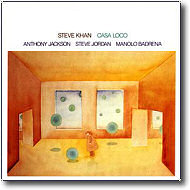 Of the four Eyewitness recordings, there's no question, in my
view, that "CASA LOCO" is truly the fan favorite. Recorded during 1983, it took our approach to music-making to
another level as it: [1] introduced the vocal talents of percussionist Manolo
Badrena and; [2] introduced the full usage of Anthony Jackson's
6-string Contrabass guitar. Together these elements added new textures and
flavor to our already extended song forms. Many would point to the 12:32 title
track, "Casa Loco" with Steve Jordan's brilliant drum solo; or "Some
Sharks" which features the relentless bass work(with one of his 'signature'
sounds, that of the "pick & flanger") of Anthony Jackson. Others might point
to the more quirky pieces: "The Suitcase," "The Breakaway," or our
deconstruction of the Pyramids' surfing classic, "Penetration." For me, when all
is said and done, no piece on this recording, perhaps in all the recorded work
of this group, stands out like "Uncle Roy." Other than the 'sweetening'
of my overdubbed 'Strat'(with a volume pedal) to enhance the chordal textures
with harmonic clusters, everything was performed live, one take, and one take
only. If you only listen and consider the brilliance of Anthony Jackson's bass
playing and Manolo Badrena's other worldly percussion, that's enough to
demonstrate how very special this performance was. Of the four Eyewitness recordings, there's no question, in my
view, that "CASA LOCO" is truly the fan favorite. Recorded during 1983, it took our approach to music-making to
another level as it: [1] introduced the vocal talents of percussionist Manolo
Badrena and; [2] introduced the full usage of Anthony Jackson's
6-string Contrabass guitar. Together these elements added new textures and
flavor to our already extended song forms. Many would point to the 12:32 title
track, "Casa Loco" with Steve Jordan's brilliant drum solo; or "Some
Sharks" which features the relentless bass work(with one of his 'signature'
sounds, that of the "pick & flanger") of Anthony Jackson. Others might point
to the more quirky pieces: "The Suitcase," "The Breakaway," or our
deconstruction of the Pyramids' surfing classic, "Penetration." For me, when all
is said and done, no piece on this recording, perhaps in all the recorded work
of this group, stands out like "Uncle Roy." Other than the 'sweetening'
of my overdubbed 'Strat'(with a volume pedal) to enhance the chordal textures
with harmonic clusters, everything was performed live, one take, and one take
only. If you only listen and consider the brilliance of Anthony Jackson's bass
playing and Manolo Badrena's other worldly percussion, that's enough to
demonstrate how very special this performance was.
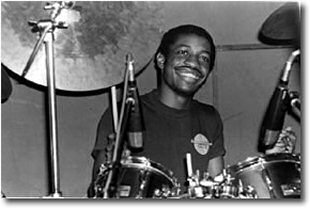 As we were
preparing for the recording, we still rehearsed once or twice per week at Steve
Jordan's downtown loft near the Chelsea area of Manhattan, that is to say, New
York City. Some days I don't know exactly what we accomplished, but we certainly
laughed a lot and there exists some classic quotes on our rehearsal CSTEs from
those days. When I brought in "Uncle Roy" to work on, as always, I had some very
clear ideas about what I was looking for, but, in working with three other very
head-strong personalities, my instructions, or 'suggestions,' were to be, in the
end, completely ignored. I can tell you with complete assurance that I told
Steve Jordan: "Listen Steve, this is kind of an Elvin Jones thing,
O.K.?" He listened, and then gave me a look which seemed to say, "Fo'get it, you
ain't gonna hear that.....but here, check this out!" And, of course, what he did
play has become one of the most imitated drum approaches in recent memory.
Firstly, he turned off his snares and approached the groove element by beating
the living crap out of his ride cymbal. In the end, that actually gave me the
kind of texture I was looking for because a ride cymbal with 'sizzles' in it is
such a huge part of the Elvin Jones sound. So, I suppose, at least in
part, I got some of what I was hoping for, but truly, I got much more than I
could have ever hoped for. As we were
preparing for the recording, we still rehearsed once or twice per week at Steve
Jordan's downtown loft near the Chelsea area of Manhattan, that is to say, New
York City. Some days I don't know exactly what we accomplished, but we certainly
laughed a lot and there exists some classic quotes on our rehearsal CSTEs from
those days. When I brought in "Uncle Roy" to work on, as always, I had some very
clear ideas about what I was looking for, but, in working with three other very
head-strong personalities, my instructions, or 'suggestions,' were to be, in the
end, completely ignored. I can tell you with complete assurance that I told
Steve Jordan: "Listen Steve, this is kind of an Elvin Jones thing,
O.K.?" He listened, and then gave me a look which seemed to say, "Fo'get it, you
ain't gonna hear that.....but here, check this out!" And, of course, what he did
play has become one of the most imitated drum approaches in recent memory.
Firstly, he turned off his snares and approached the groove element by beating
the living crap out of his ride cymbal. In the end, that actually gave me the
kind of texture I was looking for because a ride cymbal with 'sizzles' in it is
such a huge part of the Elvin Jones sound. So, I suppose, at least in
part, I got some of what I was hoping for, but truly, I got much more than I
could have ever hoped for.
My instructions to Anthony weren't
really quite as clear because, for all the [I] and [A] sections,
all I described for him was that this was simply an Eb minor pedal. Harmonically
speaking, each of the triads, which precedes an Ebm7(sus) voicing of one form or
another, could easily be seen as an extended form of a Bb7(alt.) chord. To be
more specific, the G-triad would form part of a Bb7(13b9) chord; the E-triad
would form part of a Bb7(b9b5); and the C-triad would form a Bb7(13/9b5). What
you also see and hear is the usage of upper neighbor relationships(bar 1), and
common tone relationships(bar 3) as well. In bar 4, you can see that the
relationship of the top voice goes down a minor-third which should be seen as a
very bluesy interval. This is pretty much true for bar 7 as well where the top
voice ascends by a whole step, another interval which could be viewed as having
a bluesy feeling to it.
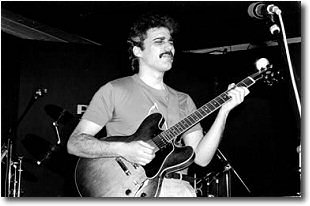 As always, here, you are presented with a
lead sheet, and what you now see is far more than what I initially wrote for
Anthony in those sections. You are now looking at a composite. And it's a
composite of the the recorded performance, but also additions we made after live
performances. I have attempted to transcribe bits and pieces of what Anthony
played, but where sections were repeated, obviously I couldn't put in
everything. No matter what, this just shows you, in part, his brilliance as a
player, as a music-maker. Truly, in this regard, a bassist without peer. I
remember consulting with Anthony during the process of assembling all our
written music for the book, "GUITAR WORKSHOP SERIES: STEVE KHAN"(Warner
Bros.), which was really rather poorly titled, and should have been called: "THE
EYEWITNESS SONGBOOK," because that's what it was. Anyway, when I was writing out
"Uncle Roy," I asked Anthony, "What should I write down to represent the bass
part?" And so he begrudgingly gave me a few little suggestions, but basically
told me after the first couple of bars, "Oh, just say, continue à la
Jamerson." In Anthony's mind, his approach to a piece like this, perhaps to
almost anything, is a tribute to one of his great heroes, Motown bassist
supreme, James Jamerson. In addition to Anthony's incredible rhythmic
touch on the instrument, you would have to include his usage of space, and his
gorgeous and full long notes. Playing with Anthony is a constant conversation, a
dialogue, and one must always remain alert. I think we have a wonderful musical
partnership because my approach allows him the space and the harmonic
flexibility to be himself at all times. Virtually every voicing I play, because
they are purposefully vague/shadowy, could be harmonized in any number of
different ways and Anthony always makes the most of this freedom. As always, here, you are presented with a
lead sheet, and what you now see is far more than what I initially wrote for
Anthony in those sections. You are now looking at a composite. And it's a
composite of the the recorded performance, but also additions we made after live
performances. I have attempted to transcribe bits and pieces of what Anthony
played, but where sections were repeated, obviously I couldn't put in
everything. No matter what, this just shows you, in part, his brilliance as a
player, as a music-maker. Truly, in this regard, a bassist without peer. I
remember consulting with Anthony during the process of assembling all our
written music for the book, "GUITAR WORKSHOP SERIES: STEVE KHAN"(Warner
Bros.), which was really rather poorly titled, and should have been called: "THE
EYEWITNESS SONGBOOK," because that's what it was. Anyway, when I was writing out
"Uncle Roy," I asked Anthony, "What should I write down to represent the bass
part?" And so he begrudgingly gave me a few little suggestions, but basically
told me after the first couple of bars, "Oh, just say, continue à la
Jamerson." In Anthony's mind, his approach to a piece like this, perhaps to
almost anything, is a tribute to one of his great heroes, Motown bassist
supreme, James Jamerson. In addition to Anthony's incredible rhythmic
touch on the instrument, you would have to include his usage of space, and his
gorgeous and full long notes. Playing with Anthony is a constant conversation, a
dialogue, and one must always remain alert. I think we have a wonderful musical
partnership because my approach allows him the space and the harmonic
flexibility to be himself at all times. Virtually every voicing I play, because
they are purposefully vague/shadowy, could be harmonized in any number of
different ways and Anthony always makes the most of this freedom.
As we
travel through the song form, we again play [A] but this time we take a
2nd Ending and play [A3]. On the recorded version, the line you now see
at bar 3 of the [A3] was only played by the guitar, but, as we prepred
this tune for live performances, Anthony wanted to double the line with me. And
so, you now have it written in as we later performed it. This, in turn, brings
us through [B2] and the addition of [B3] which serves as a
transition to a new section which, for the purposes of this tune, is our
'bridge,' our release. What makes this performance so successful is the group's
usage of exaggerated dynamics with each section having its own ceiling and
basement. In our case, some of this was accomplished by sound musical
'instincts' and in other cases, it was done by group discussion.
Letter [C] is of special interest because I don't think it
could be performed without the Contrabass guitar and it's upper register. The
section is really just an interlude, a rather long crescendo leading us back
to [I2]. I believe that almost all the double-stops I wrote for Anthony
were performed on his 'G' and 'C'-strings. 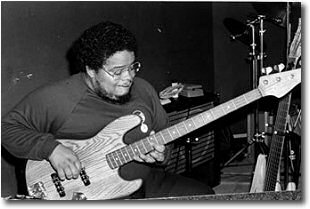 Mainly it all
contributes to making a unique sounding clustered texture as we both performed
it using our volume pedals and dialing up each voicing. If you were to
experiment with this section on a keyboard, it would sound fine, and it was
actually composed that way. Just remember that the guitar voicings would come
down an octave and the bass double-stops would be played where you see them.
When we do arrive at [I2] Anthony and Steve Jordan are in full flight,
and the group is bashing which leads us to the [Tag], a 'rocket' or
send-off into the guitar solo at [D]. The [Tag] line is really
just a long guitar/bass unison which paraphrases part of the [A] melody
and lands on the false cadence of Emaj7(#4) which is held out until the solo
begins. Mainly it all
contributes to making a unique sounding clustered texture as we both performed
it using our volume pedals and dialing up each voicing. If you were to
experiment with this section on a keyboard, it would sound fine, and it was
actually composed that way. Just remember that the guitar voicings would come
down an octave and the bass double-stops would be played where you see them.
When we do arrive at [I2] Anthony and Steve Jordan are in full flight,
and the group is bashing which leads us to the [Tag], a 'rocket' or
send-off into the guitar solo at [D]. The [Tag] line is really
just a long guitar/bass unison which paraphrases part of the [A] melody
and lands on the false cadence of Emaj7(#4) which is held out until the solo
begins.
For me, this particular solo section embodies everything
that's wonderful about my experiences as part of this group for it should not
really be viewed so much as "guitar solo" but more as a group improvisation, a
group conversation which is perhaps led by the guitar but not much more than
that. How can I best describe what it was like to be playing within a musical
texture such as this? Perhaps it could be said that it's like walking into a
very, very old house, which has no electricity, after midnight and being told
that somewhere on the first or second floor are some candles. Then you fumble
around in the dark hoping to find them, but, sometimes bumping into things which
appear seemingly out of nowhere. Maybe the better visual image is that of
walking into an unexplored cave for the first time?
Firstly, how
can I describe in words what Anthony brings to all this? Perhaps words like:
sinister; ominous, prowling; lurking; skulking; hiding; stalking; searching;
probing, pure evil. For those of you who have the full performance on the
recording, you can hear how his usage of long tones, as the solo begins, gives
me the room and the freedom to create something melodic, something connected to
what has come before during the composed sections. Without Anthony providing
that kind of support, it would not have been as effective. And what about the
textures of Manolo? Words like: eerie; spooky; frightening; startling, strange,
funny, and science fiction come to mind. How about Manolo's comical description
of his own playing: "I'm the Puerto Rican 'Spike' Jones!" Almost anything
you hear as keyboard-like is actually Manolo and his battery of traditional
and/or very odd percussion instruments. Whistles and gongs, the screaming and
the yelling, all performed before a microphone, which then feeds those 'natural
sounds' into some kind of a digital delay, where it is then warped into another
dimension with the spontaneous and random turning of a dial. Remarkable, truly
remarkable! Together, Anthony and Manolo created a texture which I will never
forget and I remain proud that "Uncle Roy" captured some of that.
I know that the word 'genius' gets thrown around far too often
but I am absolutely convinced that these two brilliant players possess just
that, 'true genius.' And I am humbled and honored to have shared this group with
them. I remember actually taking the time to sit and listen to Manolo's
performance in 'solo' just to make certain that we weren't missing something
when mixing, and I was struck by just how remarkable it was to hear his 'mind at
work.' 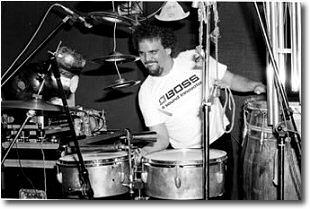 And then, the final ingredient, you add the relentless hammering groove
of Steve Jordan and all the beautiful sounds of each drum and each cymbal; and
suddenly, the mix of personalities and styles is perfect. Again, you have to
appreciate how Steve waited and allowed this section to find its own form and
shape. By just using his ride cymbal, and playing accented crashes, reacting to
what was going on he contributed propulsion without overwhelming the mood. Then,
as if by magic, when Anthony shifts to playing moving half-notes Steve begins to
pound out the 'big beat!' And then, the final ingredient, you add the relentless hammering groove
of Steve Jordan and all the beautiful sounds of each drum and each cymbal; and
suddenly, the mix of personalities and styles is perfect. Again, you have to
appreciate how Steve waited and allowed this section to find its own form and
shape. By just using his ride cymbal, and playing accented crashes, reacting to
what was going on he contributed propulsion without overwhelming the mood. Then,
as if by magic, when Anthony shifts to playing moving half-notes Steve begins to
pound out the 'big beat!'
In concept, a solo such as this
really only has a beginning and an end which get discussed. The beginning, a
point of departure: where, we all know that we have come from that Emaj7(#4)
chord, and should resolve that to Ebm7(sus), where the solo begins. We also know
that somehow, no matter what route we take, we will arrive back at that same
Ebm7(sus) chord before moving on into [I3]. The only things I keep in
mind while 'leading' the conversation is to try and utilize parts of the melodic
and harmonic materials previously presented in the tune. In doing this, it keeps
everything connected, centered and focused. This holds true no matter how far
away we might stray on any given night. When we finally re-emerge at
[I3], we're in the home stretch of the piece. Here at bar 6, you have one of
Anthony's great moments. One which presents his mastery of the instrument, and
the rhythmic placement of notes, a flash of brilliance. The line he plays which
begins on an 'A'-natural, which is a blue note in this key, but the 'scale'
itself really seems to outline Eb-Phrygian because of the 'E'-naturals and Cbs
which do not appear in Eb-Dorian, but do appear in parts of the [A] melody
sections. When the long line of 16th-notes finally lands on a Bb at the downbeat
of the next bar, it has found that note after surrounding it by both of its
chromatic upper and lower neighbors. It was all intuitive, improvised, but
brilliantly done and executed.
Once we have arrived at [A4], we
simply follow the piece out using a D.S. sign to take us back to the 2nd
ending (on Pg. 2), through [B2] and [C] on our way to the [Tag]
and the true ending at the top of Pg. 4. So, if we were to lay out this
tune, for the purpose of memorization in an "Alphabet Soup" format, what might
it look like:
[I] - 4x
[A]
[A2] - 1st End
[B]
[I] - 2x
[A]
[A3] - 2nd End
[B2]
[B3] -
Transition
[C]
[I2] - 2x
[Tag]
[D] -
Solo(Open)
[I3] - 2x - on Cue
[A4] - D.S. to
[A3] - 2nd End
[B2]
[B3] - Transition
[C]
[I2] - 2x
[Tag] - End
I actually know many musicians
who prefer to memorize a piece, once they have committed the actual notes to
memory, solely by its form. Sometimes keeping the form written on a piece of
paper down at their feet, or by their monitor. If it works, great!!!
More
than usual, it's a true, true pleasure to be able to present this Eyewitness
'classic' at KHAN'S KORNER and to share a few of my personal feelings about
being a part of it all. I still be very lucky that we did this. By the way, the
title comes from one of Buck Henry's most popular characters("Uncle Roy,"
the overly "neighborly" baby-sitter) on the 'old' "SATURDAY NIGHT LIVE."
So, here's wishing everyone a wonderful summer.
PEACE.....EVERYWHERE......PLEASE!!
Uncle Roy
page 1 -
page 2 -
page 3 -
page 4 -
page 5
Audio File (MP3 4.1 MB)

Insert a comment
©
2002, 2004 Jazzitalia.net - Steve Khan - All rights reserved
|
© 2000 - 2025 All the material published on Jazzitalia is exclusively owned by the author. Moreover it is protected by International Copyright, so it is forbidden any use of it which isn't authorised by the rights' owner.
|
This page has 4.560 hits
Last Modified Date: 27/11/2004

|
|

